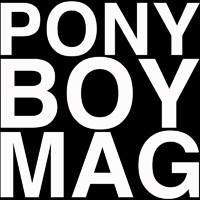MANI
NICO MALVALDI
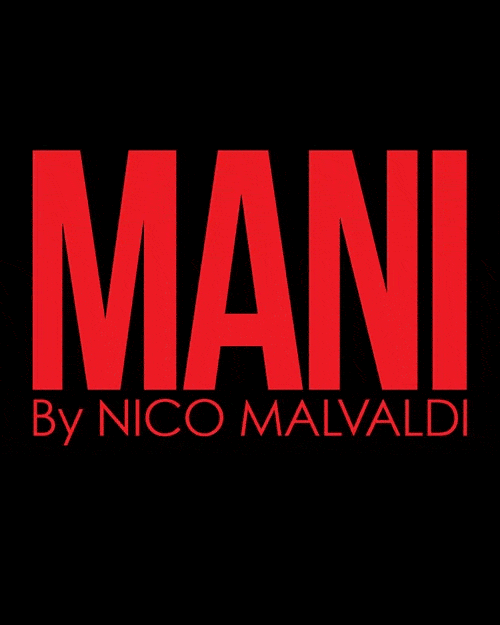
Nico Malvaldi is the publisher and photographer of the New York City rock “zine” known as MANI. Available in newspaper format, as well as limited booklets, his photographs document the essence of the downtown, underground music scene that is both alive and kicking at venues like TV EYE and Berlin. The beautiful black and white, point-and-shoot images are filled with the electric energy of fantastic young bands performing on stage, as well as the stylish, tattooed pretty people who attend these events. We are in awe of his MANI project and just love his images!
PONYBOY: Nico, your images are so raw and gritty, everything that rock and roll is about. How did you get into photographing the New York underground rock scene?
NICO MALVALDI: My love for dive bars and loud music brought me “here. Dive bars are something absolutely exotic to me, as we don’t have anything like them, where I grew up. I find them straightforward and honest, similar to the feeling I get from photographing shows these days.
These concerts are pretty special in my opinion. There is an intoxicating excitement in those rooms, an uncompromisable conviction to be in the right place, somewhat suspended in time, but also with the cynical disillusion of shrewd inhabitants of a metropolis. I really cherish the contemporary underground scene.
Years ago I was photographing people in dive bars, and one day I stepped into The Trash Bar in Brooklyn. They were hosting the CBGB’s music festival. It was then that I realized that musicians don’t really object if you take photos of them, and also showgoers won’t pay too much attention to you either. So from then on, to take my photos, I kept looking for bars, but also with live music.
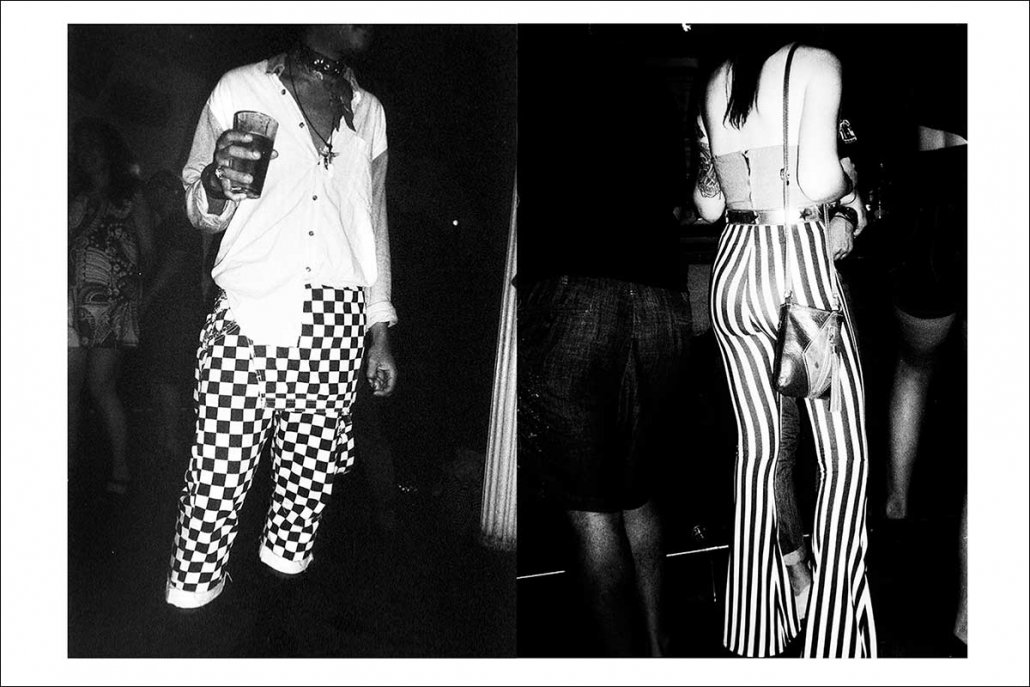
Looks at Berlin. photos NICO MALVALDI
PONYBOY: You’re originally from Italy. Tell us how you stumbled into photography.
NICO MALVALDI: Photography was always an interest of mine, but only in 2001 did I begin pursuing it more seriously. In San Francisco, I met two awesome photographers who opened their studio to me, let me hang out, and showed me the craft. I learned to use the darkroom, and the studio equipment and became familiar with the “language” of photography. After that, I fortunately, stumbled into a series of jobs that gave me the possibility of growing my experience as a professional photographer in several different fields: sport, reportage, fashion and dance. Those years were crazy, actually.
I covered the Women’s World Cup of Soccer. I moved to New York in 2004, but also began photographing the Elton John Academy Awards viewing parties, and SAG Awards events in Los Angeles, which I did for a few years. In New York, I was also covering the Human Rights Watch events. A year later I was in Paris shooting the opening of the first mono-brand shop of this Italian fashion company, Save The Queen, for which I began doing fashion catalogs for the following several years.
In 2008 I began a relationship with Ballets with a Twist, a ballet company from downtown New York, which I still work for today.
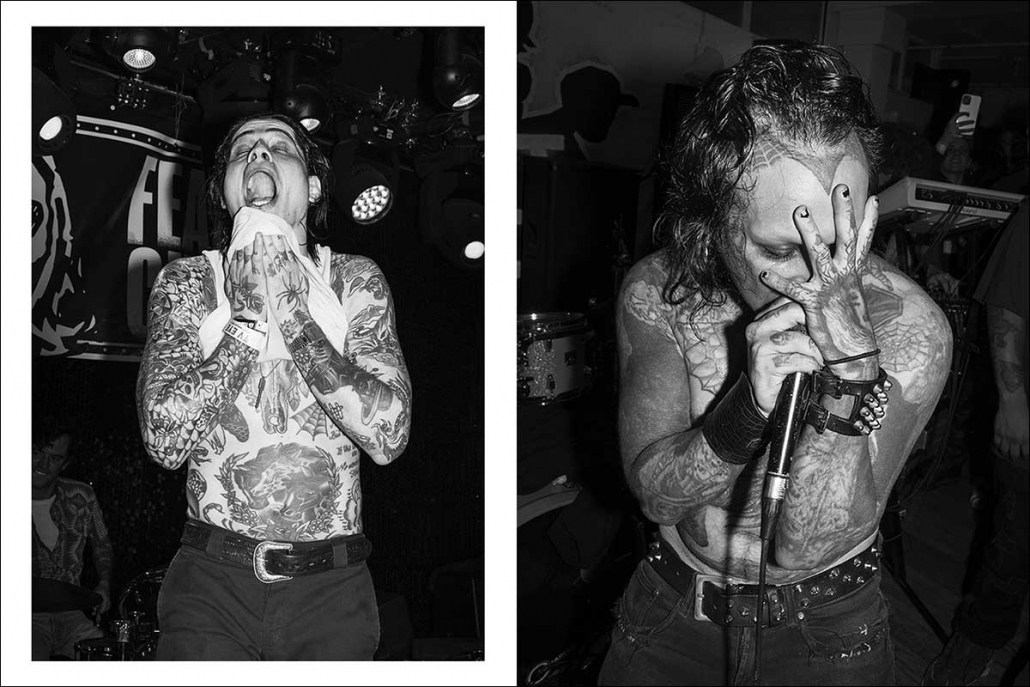
Left: Dave from Wyldlife at TVEYE. Right: Blue Anxiety at Project Reach. photos NICO MALVALDI
PONYBOY: How did the MANI publication actually come about? And what does the term mean?
NICO MALVALDI: MANI is the acronym of my full name: MA lvaldi and NI co. The first three issues of “MANI the papers”, as I like to call it, were created as portfolios. In fact, on the cover, you still read ‘Tabloid Portfolio Series.’ In the past, photographers were supposed to have printed portfolios, and considering the type of photography I was doing at the time, I thought that the newsprint medium could have been a pretty interesting one, for me.
It was a prophetic coincidence that issue No. 1 of MANI was dedicated to The Trash Bar, a dive bar with live music, because besides a few exceptions, since then, the portfolio series has developed specifically around featuring many different bars with live music of New York.
PONYBOY: It appears that MANI started out as a newspaper and seems to have evolved into a booklet and mini-booklet as well. Are they for sale at music venues or are they given out to attendees?
NICO MALVALDI: Yes, I’ve recently branched out and begun producing very limited editions of two new booklets: MINI MANI and MANI SQUARED. They are printed in full color, although most of the images are in black and white, and they feel a little more sleek and sophisticated, although still very rock and roll. I simply wanted a way to put in print any random nights I photograph, without having to produce the quantity of the papers, which can only be printed in a minimum amount of 1,000 copies.
These new “publications”, with the collaboration of the bands, also feature the lyrics of some songs. I think it’s important and very interesting to know what the musicians are actually writing about.
For these booklets, I first contact the bands featured in the issue, and then I make a post on Instagram for people to get in touch with me directly. Then they send the payment using whatever platform, and we decide where to meet for the delivery. I guess I should start bringing them to the shows as well, but it complicates things a bit for me. I am also excited to say that I actually have a few “collectors” of these new zines.
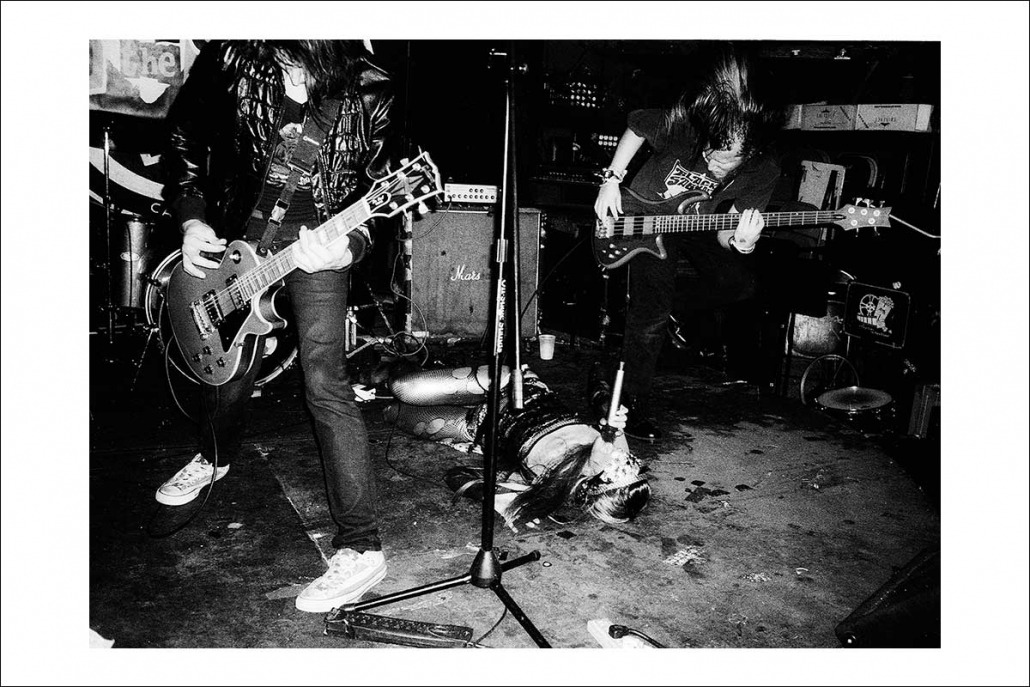
J and the 9s at Trash Bar. photo NICO MALVALDI
PONYBOY: Are the actual layouts for MANI designed by you?
NICO MALVALDI: Yes. I absolutely enjoy that process. I also curate a magazine with the dance company I work for (Ballets with a Twist), and I am actually in conversation with a more established rock band, to design their experimental paper which is published every trimester.
PONYBOY: At some point,you were involved in the MANI project with a mutual friend of ours, Hayley Gianoli. What was her role?
NICO MALVALDI: Hayley has been utterly instrumental in developing the MANI project. One night, outside Berlin Bar, I took a photo of her, as she looked as fabulous as she always does. We exchanged contacts and a few days later I asked her to meet. I showed her my first three papers and proposed to print something similar for her events. She liked the idea, and so I started showing up at her parties to take photos. She introduced me to her friends, and through her, I learned about more bands and bars to photograph. We made a few issues together, also counting on some financial support from Jesse Malin, as we featured his bars (Niagara, Berlin and Coney Island Baby).
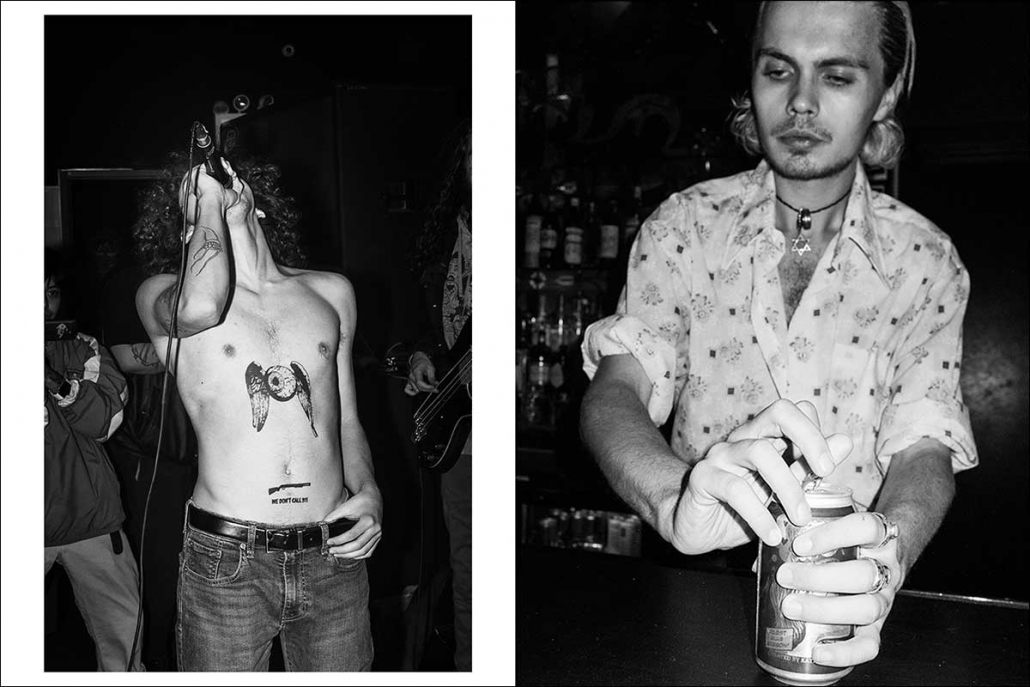
Left: Feramone at Brooklyn Monarch. Right: Bartender at TV EYE. photos NICO MALVALDI
PONYBOY: Would you say that you’re a self-described music fan? Do you agree with us in stating that on average the best photos from a “scene” are usually from photographers that are somewhat involved or part of that scene? There is a comfort element – you are one of them.
NICO MALVALDI: Definitely. I agree that when you are part of something you’re able to portray it much more intimately and accurately. In my case, it’s a combination of loving the music, and also the environment. I enjoy any kind of performance, as I highly respect performers in general, but I don’t love photographing just any event. I like them to be in some attractive-looking context, as I want to be visually stimulated by it.
PONYBOY: Are your nightlife images shot digitally or on film? What camera do you use?
NICO MALVALDI: The first 16 of 19 issues of MANI “the papers” were all shot on film, mostly with an Olympus point-and-shoot and Contax G2 and T2. Kind of following the “strategy” of my dive bar photography, I wanted the photos to be very candid and not really curated. Four months ago, I switched to digital. I went to photograph a three-day event at TV EYE, fearcityfunfest, with the intention of producing some papers.
Besides film becoming absolutely expensive for such a project, I wanted to have a little more control over the images. Because I wanted to feature every single musician who performed at the festival in the paper, 22 bands, averaging four people per band. It was a lot. I couldn’t risk missing anyone, so I went with a Nikon Z6.
To be completely honest, I don’t like the digital images as much as the ones shot on film, I never did. But I think digital gives you many creative opportunities and the images still tell the story.
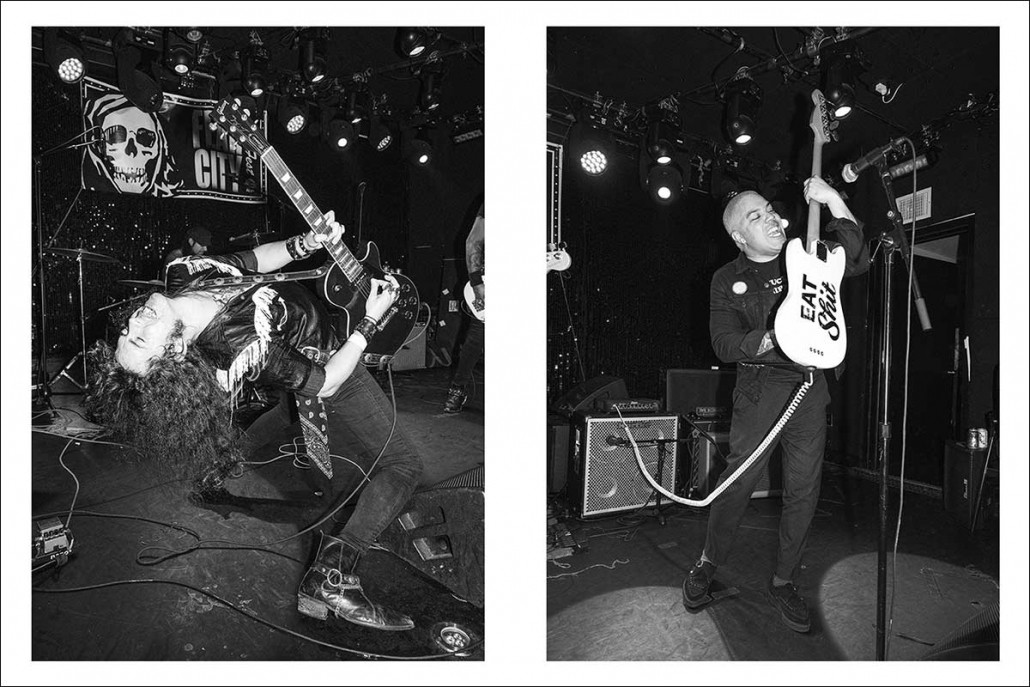
Left: Brandon Berger of Killer Hearts at TV EYE. Right: Manuel of Malavista. photos NICO MALVALDI
PONYBOY: Tell us about the battles of shooting at shows/live music venues. What do you as a photographer find yourself going up against?
NICO MALVALDI: Mainly myself, because conceptually, I kind of hate the fact that the first row in front of the stage is often made of just photographers. For what I can, I try to be as considerate as possible to the musicians and the showgoers. If I see that people want to be right in front of the stage to enjoy the concert, I move to the side and try to find a different spot for my photography.
That being said, it seems very understandable that photographers are also part of the scene. So when everyone is cool with sharing the space, everything becomes fair game. I love when the crowd gets rowdy. I am fully happy to get a few pushes for the sake of a few photos. I find myself very much in my element at those concerts.
PONYBOY: Do you find that bands/people at the venues are more willing to pose for you now that you have a name in the scene, an actual publication?
NICO MALVALDI: Maybe. I wouldn’t exactly say that I “have a name in the scene”, but for sure more people know what I do with my photos, than they did before.
I think that having more people talk to me, like musicians saying hello and so on, makes everyone around feel that I belong there. Perhaps, those who don’t know me, won’t feel as weird that I am taking pictures of them. Of course, I’m talking about people in the crowd, as the performers do their thing regardless.
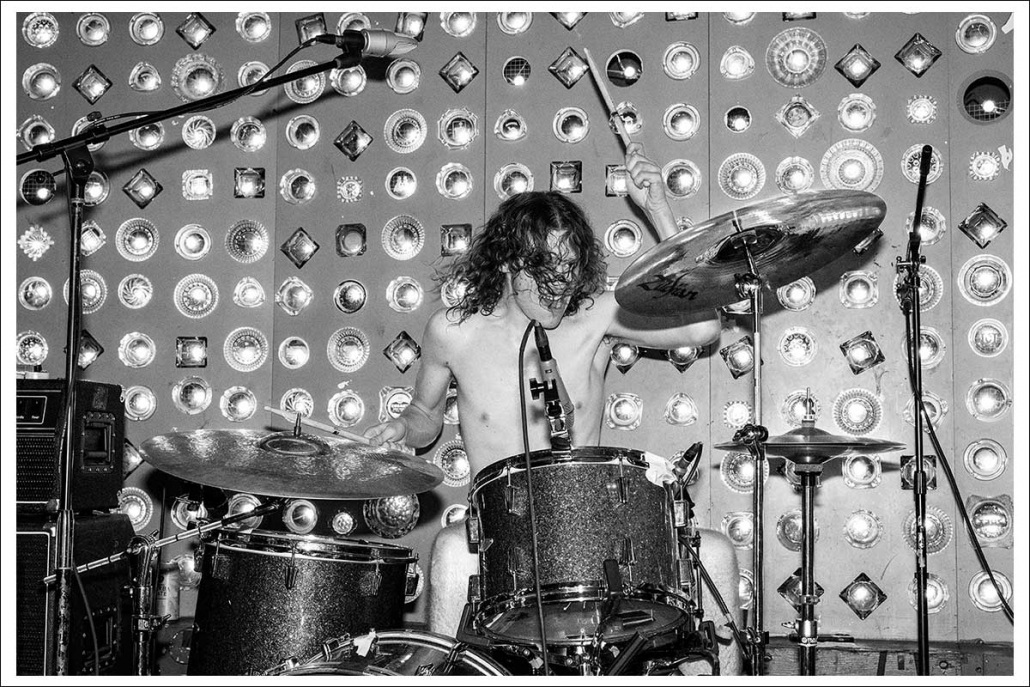
Macky of The Bobby Lees at Baby’s All Right. photos NICO MALVALDI
PONYBOY: Are shoots ever planned accordingly with a band for a cover of MANI? Or are things done more organically in that you just never know who or what might make the cover?
NICO MALVALDI: Nothing is ever planned for the papers. Especially because I was using film until recently. It would take some time for me to develop the film, then I would have to scan it (I used to do it by myself, back in the day). Then I’d go through the selection of the shots and finally the layout. It would take me a while to put an issue together. Also, I wanted to collect photos that would archive as widely as possible – in terms of time. I didn’t want an issue to look like it was photographed in two weekends.
“Fun” fact: the issue dedicated to TV EYE was so stretched in time (also because of the pandemic) that some photos in it are taken almost three years apart from each other.
PONYBOY: Would you say that you have a certain camaraderie with other nightclub photographers that are in the scene? Or does it get competitive at times?
NICO MALVALDI: I would define the relationship with the other photographers as “respectfully competitive”. When the shows are not completely packed, photographers move around the room pretty organically and are aware of each other. When the shows are more popular, your positioning becomes more important and therefore is “defended” more decisively, but I always find more camaraderie than anything else in there. When other photographers get in your way, you have to remind yourself how many times you may have inadvertently done the same to others. So It’s all part of the game.
I always thought that the fewer people you know at a show, the less distracted you would get. But I have to say that I’m now happy to see familiar faces and engage in quick chats. It creates a nice sense of community, which I appreciate very much.
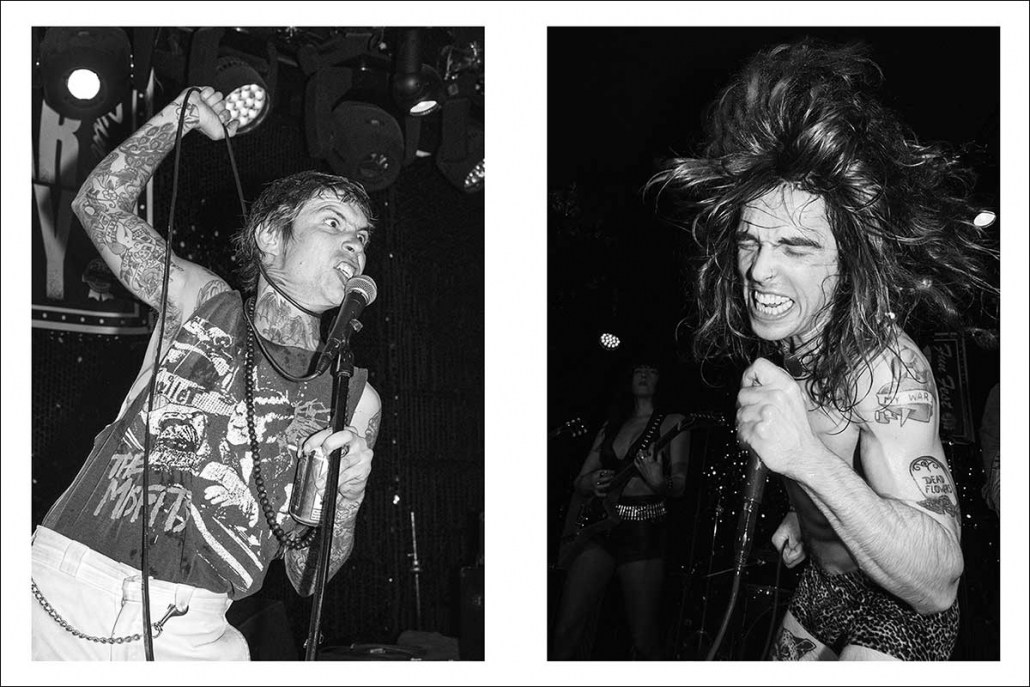
Left: Lyle of the OC Rippers at TV EYE. Right: Mattie of Killer Kin. photos NICO MALVALDI
PONYBOY: On average, how often would you say that you’re out and about shooting at shows/venues?
NICO MALVALDI: It depends. In theory, I try to go at least once a week. But in reality, I only go when I can. I live in Astoria. I need four trains to get to Bushwick. It’s obviously not impossible, but commuting time could play a role, especially going back home late at night. There are shows that I want to go to because of the line-up, as well as others that I feel I should go to because I don’t know any of the bands performing or the venue as well.
The main problem is that if I take photos, I want to do something with them. Maybe a paper, an exhibit, or some other form of printed matter. So sometimes I have to restrain myself from going.
PONYBOY: What venues are your favorites to shoot at? Since starting MANI, are you getting comped at the door now?
NICO MALVALDI: Photographically speaking, all venues have their pros and cons. Now that I have been doing this for a few years, I feel more prepared knowing what to expect from most of them. But ultimately, every night is different and it can turn into an awesome one at any moment.
Once I noticed that several photos I selected for an exhibit, were all taken at Our Wicked Lady, but they weren’t necessarily the ones of performers.
I only started getting some comps very recently because I began sharing photos more easily now that I shoot digitally. I generally don’t ask for a comp ticket, but if someone offers, I am happy to accept, as expenses add up.
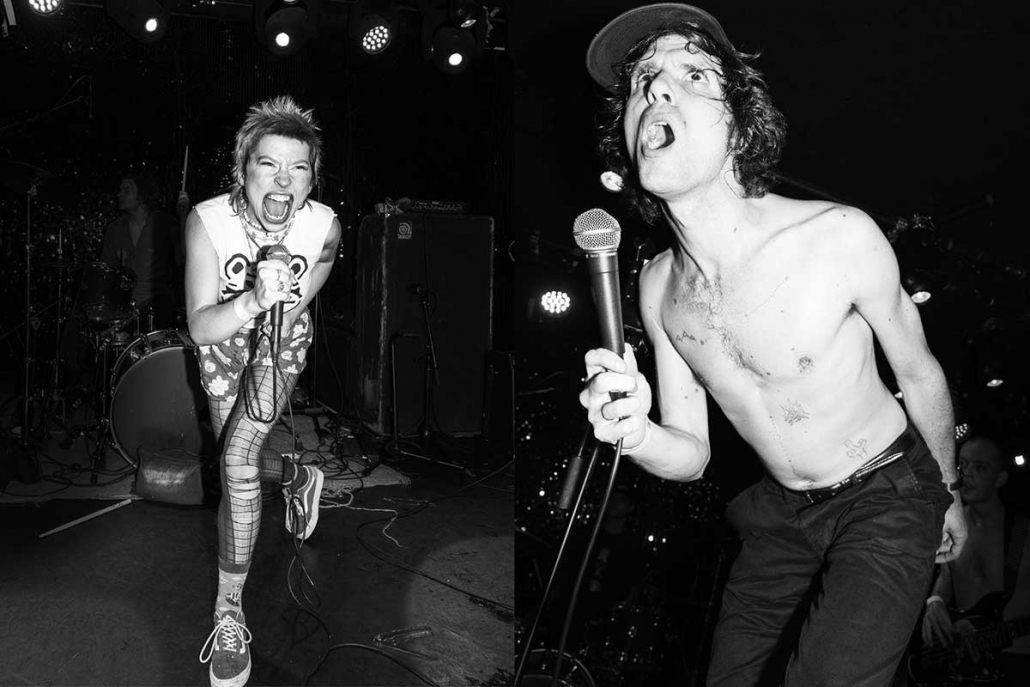
Left: Pat of the Schizophonics at TV EYE. Zach of Dead Tooth. photos NICO MALVALDI
PONYBOY: What bands are you a fan of? And what band would you say has given you the most visually for your photos, when they’re performing on stage?
NICO MALVALDI: For different reasons, I am a fan of most, if not all the bands I have photographed. It’s pretty rare I get disappointed at a show. They all blow my mind, every time. Photographically speaking, Dead Tooth has “given” me several great photos, and some of the most fun concerts. Native Sun was one of these bands that I wanted to see for the longest time and I was never able to. They turned out to be both very photogenic and a lot of fun to watch. Alexandra Blair (The Silk War), Acacia (The Advertisers) and Chuck Bones (The Trash Bags) have also given me several pretty good photos.
Chuck Bones made it also on the MANI t-shirt, and everyone who bought it keeps telling me about the many comments they get from the t-shirt. I love it!
PONYBOY: So many big, well-established magazines have ceased actual print publication and gone straight to the internet only. You know that term, PRINT IS DEAD. What drives you to print, as opposed to say photos on a website with an Instagram profile?
NICO MALVALDI: I know the term, in fact, CREEM magazine came back from the “dead” last year, and on their first cover the message read: “ROCK IS DEAD, SO IS PRINT.” I find this very fitting to your question. I guess the short answer for what drives me to print, is that I love it. I truly do. I love making it, looking at it, and touching it.
Print is more expensive to produce, and the internet offers you a much broader reach. This is undeniable. So I understand why the industry has been going in that direction. But in my little world, I still see my papers as portfolios of my photography, recording a time and place in a form that I like. And also making my pictures look cool. Although I secretly wish these papers will be collected by the Museum of the City of New York and used as a legacy to this time in New York City.
The only ambition I have for them is for people of the community to save them in a random drawer, and stumble across them years later, remembering those exciting nights of rock and roll!
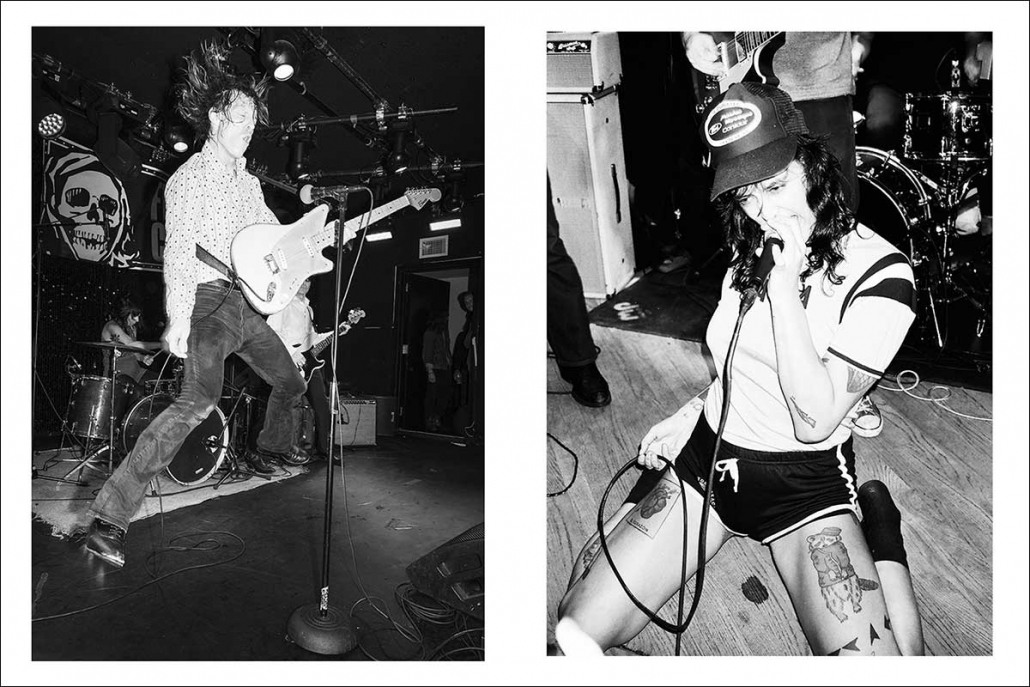
Pat of the Schizophonics at TV EYE. Acacia of The Advertisers at Berlin. photos NICO MALVALDI
PONYBOY: On average, what is the turnaround time for printing and publication of a MANI? In any of the formats. And how often is it distributed?
NICO MALVALDI: There is no planned timeline for the papers, or for any of the other different formats. The whole thing has been working itself out without planning anything, from the very beginning. I have a couple of issues that I’m working on right now, and although I love doing it, I’m also trying not to do too many.
At first, it was cool being able to print issue after issue. But now that many are in circulation, I like to leave more time between releases. It makes it a little more special when it finally happens.
PONYBOY: Does Ilegal Mezcal being a sponsor pay for your printing costs?
NICO MALVALDI: Yes, it does! They have been the most supportive of me, and I couldn’t be more grateful for them. I often hit them with ideas for new projects, and they always answer very openly and listen to what I have to say.
We recently put together a collaboration between them and Pabst Blue Ribbon to create an event in celebration of FEAR CITY FUN FEST, which I mentioned earlier, that I photographed last November. All together with Jenny Thunders, we threw a show at Ilegal Mezcal HQ in Greenpoint, with a large photo exhibit, three issues of MANI the paper, and Killer Kin (an awesome band from Connecticut) in concert. It was absolutely fantastic, and another example that support like theirs helps the community exist.
To be completely transparent I would like to mention that I’ve also printed some papers with the support of The Cast (which is shipping MANI all over the world with their online orders!) and Jim Beam, (MANI No 11) sponsor of the Winter Madness at OWL. Some of the venues themselves have helped me at times with some of the production costs – Our Wicked Lady, The Broadway and Baby’s All Right. I can’t be thankful enough to any of these people who helped me throughout time.
PONYBOY: What aspirations do you have for MANI? Any thoughts on a hardcover MANI one day?
NICO MALVALDI: Actually, yes! I have been working with a friend on it, laying out the groundwork and a pitch to a publisher. It’s too early to discuss, but it’s not “just an idea”.

MG of Spite FuXXX at Alphaville. photo NICO MALVALDI


